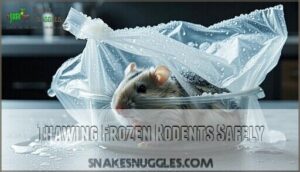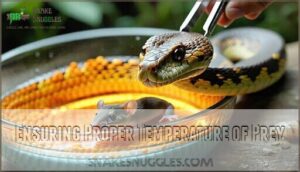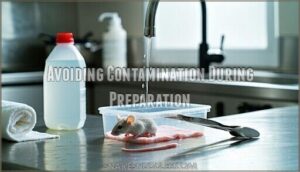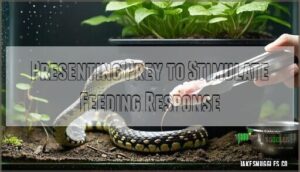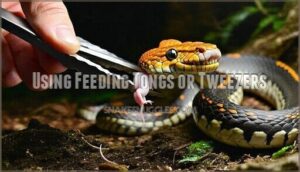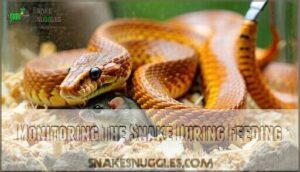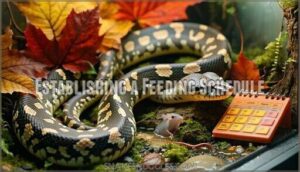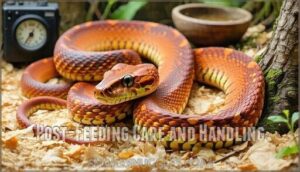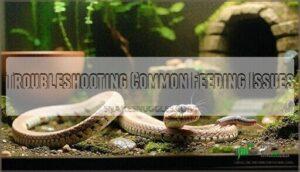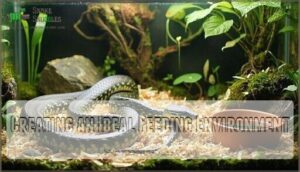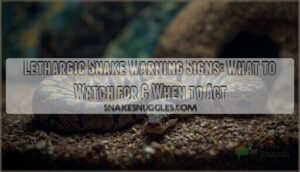This site is supported by our readers. We may earn a commission, at no cost to you, if you purchase through links.
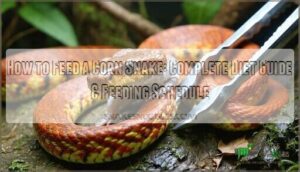
Juveniles eat every 5-7 days, while adults need feeding every 10-14 days. Thaw prey safely in warm water, then use feeding tongs to present it.
After your snake eats, avoid handling for 48-72 hours to prevent regurgitation. Choose mice or rats based on your snake’s size – pinkie mice for hatchlings, adult mice for mature snakes.
Maintain proper enclosure temperatures during digestion, and watch for feeding cues like active hunting behavior. Getting the basics right prevents most feeding problems, but there’s more to master for ideal snake health.
Table Of Contents
- Key Takeaways
- Selecting The Right Food for Your Corn Snake
- Preparing Prey Items for Feeding
- Feeding Techniques for Corn Snakes
- Establishing a Feeding Schedule
- Post-Feeding Care and Handling
- Troubleshooting Common Feeding Issues
- Special Feeding Considerations for Different Life Stages
- Creating an Ideal Feeding Environment
- Frequently Asked Questions (FAQs)
- What is the best way to feed a corn snake?
- How do I tell if my corn snake is hungry?
- What not to feed corn snakes?
- How much to feed a corn snake?
- How do you feed a baby corn snake?
- Do corn snakes need a feeding chart?
- Can you feed a corn snake as a pet?
- Should I feed my corn snake in its cage?
- Can I hold my corn snake before feeding?
- How many times a week does a corn snake eat?
- Conclusion
Key Takeaways
- Size your prey correctly – Choose frozen mice that match 1-1.25 times your snake’s midbody width, progressing from pinkies for hatchlings to adult mice for mature snakes.
- Follow age-based feeding schedules – Feed hatchlings every 5-7 days, juveniles weekly, and adults every 10-14 days to prevent overfeeding and support healthy growth.
- Thaw prey safely and present with tongs – Use warm water to thaw frozen rodents completely, then present at 98-100°F using feeding tongs to trigger natural hunting instincts while keeping your hands safe.
- Allow 48-72 hours of undisturbed digestion – Never handle your snake after feeding until it has fully digested its meal, and maintain proper basking temperatures (84-88°F) to support healthy digestion.
Selecting The Right Food for Your Corn Snake
Choosing the right food for your corn snake is essential for its health and growth.
You’ll need to match prey size to your snake’s body width and understand the differences between frozen and live options.
Appropriate Prey Size for Corn Snakes
With corn snakes, getting prey size right is vital for your snake’s health and happiness.
The golden rule: choose prey that’s 1-1.25 times your snake’s midbody diameter.
**Size matters—get it right and your snake will thrive.
Here’s what proper snake food size means:
- Pinky mice work perfectly for hatchlings under four months old
- Fuzzy mice suit juveniles as their snake girth increases
- Hopper mice match subadult growth stages appropriately
- Adult mice feed mature corn snakes weighing 18-30g each
Overfeeding risks include regurgitation and injury, while undersized prey stunts growth.
Monitor your snake’s body condition regularly—if prey leaves a significant bulge lasting over two days, it’s too large.
Conversely, prey weight that’s too small won’t support healthy development through different growth stages.
Types of Rodents Suitable for Feeding
Most corn snake owners discover that frozen mice for snakes offer the perfect foundation for their pet’s diet.
You’ll choose between pinkies vs fuzzies based on your snake’s size – pinky mice work for hatchlings while fuzzy mice suit juveniles.
As your snake grows, progress to hopper mice and eventually adult mice.
While rat vs mice debates exist, mice provide excellent nutritional value for most corn snakes.
The frozen variety available today includes different sizes to match proper prey size requirements, making feeding straightforward and safe.
Frozen Vs Live Prey Considerations
When choosing between frozen mice for snakes versus live prey, frozen wins hands down.
Live prey risks include potential snake injury prevention issues—rodents can bite and scratch your corn snake during feeding.
Frozen mouse options eliminate these dangers while maintaining nutritional value. Despite minimal frozen nutrition loss, prekilled prey provides complete nutrition.
While wild corn snakes show wild prey preference for live food, captive snakes adapt well to thawed mice.
Ethical considerations also favor frozen options, avoiding the moral complexity of feeding live animals.
Nutritional Requirements of Corn Snakes
Understanding your corn snake’s nutritional needs guarantees maximal health and longevity.
A balanced diet centers on whole prey items that deliver complete nutrition naturally.
Proper snake nutrition requires high-protein, low-fat foods.
Whole frozen rodents provide essential nutrients including calcium, phosphorus, and vitamin D3.
This approach prevents nutritional deficiencies while supporting healthy growth patterns.
Diet variety enhances your snake’s well-being:
- Calcium sources from bones prevent metabolic bone disease
- Organ meats supply important vitamins and minerals
- Hydration needs are met through prey’s natural moisture content
- Rotating prey types (mice, rats, quail) ensures thorough reptile nutrition
- Proper portion control supports obesity prevention
Monitor your snake’s body condition regularly, adjusting feeding frequency to maintain ideal weight and prevent health complications.
Captive corn snakes are often fed nutritious frozen rats to meet their dietary needs.
Preparing Prey Items for Feeding
Properly preparing prey items is vital for your corn snake’s health and successful feeding.
You’ll need to safely thaw frozen rodents, guarantee the right temperature, and handle food correctly to avoid contamination while encouraging your snake’s natural feeding response to ensure successful feeding.
Thawing Frozen Rodents Safely
Proper thawing frozen rodents prevents dangerous bacteria growth and guarantees your corn snake gets a safe meal.
Here’s your roadmap:
Refrigerator
Cold water
Room temp
Never microwave – it creates hot spots that’ll burn your snake’s mouth. Complete thawing means no frozen centers.
Consider prey item options for your snake. Your feeding safety depends on these hygiene practices and proper prey preparation techniques.
Ensuring Proper Temperature of Prey
Temperature matters tremendously when feeding corn snakes. Warming Methods like warm water baths or heating pads bring thawed prey to Core Temperature around 98-100°F. This Temperature Monitoring guarantees prime Palatability Factors and Digestion Impact for successful feeding corn snakes.
Many owners use reptile heating pads for this purpose.
Here’s why proper prey preparation temperature makes all the difference:
- Cold prey feels unnatural and gets ignored
- Proper warmth triggers hunting instincts instantly
- Right temperature aids smooth digestion process
- Overheated prey can burn your snake’s mouth
- Consistent warming creates reliable feeding techniques
Handling and Presenting Food to The Snake
Once you’ve warmed the prey properly, it’s time to safely present it to your corn snake.
Using feeding tongs keeps your hands away from striking distance while mimicking natural movement that triggers the feeding response. Many keepers find specialized snake tongs improve safety and control.
| Method | Best Practice |
|---|---|
| Tongs Technique | Grip prey by tail, keep 5+ inches away |
| Animating Prey | Gentle wiggling mimics live movement |
| Separate Container | Use feeding tub to reduce bite risk |
| Dark Feeding | Dim lighting encourages natural behavior |
| Presentation Angle | Approach from side, never directly overhead |
The key to successful prey selection lies in understanding your snake’s natural instincts and creating the right environment for feeding.
Avoiding Contamination During Preparation
Once you’ve got your prey properly prepared, maintaining feeding hygiene becomes your next priority.
Safe thawing requires clean water source and proper surface sanitization before each feeding session.
Always wash your hands thoroughly and use dedicated handling tools like feeding tongs for corn snake feeding.
Keep thawed prey separate from other foods using proper storage practices.
These feeding tips and thawing techniques prevent bacterial contamination that could harm your snake’s digestive system.
To prevent this, always sanitize feeding equipment after each use.
Feeding Techniques for Corn Snakes
Proper feeding techniques guarantee your corn snake accepts food consistently and stays healthy throughout its life.
You’ll need the right approach to present prey safely while encouraging your snake’s natural feeding response to ensure it accepts food consistently.
Presenting Prey to Stimulate Feeding Response
Once you’ve properly thawed your prey, animate prey movement triggers your corn snake’s natural feeding response.
Gently shake the rodent using feeding tongs, mimicking live prey behavior. This presentation technique awakens their hunting instincts.
Try scenting prey with chicken broth if your snake seems hesitant. Consider using a separate container in a dark environment for shy feeders.
These feeding techniques make feeding corn snakes more successful and natural.
Using Feeding Tongs or Tweezers
Feeding tongs or tweezers are your best friends in the context of safe handling during corn snake feeding. These tools create essential bite prevention by keeping your fingers far from striking range.
Choose tongs for larger prey or tweezers for smaller items, allowing you to control the feeding process while mimicking movement patterns that trigger your snake’s natural hunting instincts.
- Tongs vs Tweezers: Select 12-inch tongs for adult mice, tweezers for pinkies
- Safe Handling: Maintain 6+ inches between your hand and snake’s head
- Reducing Stress: Move prey slowly and steadily to avoid startling your snake
- Presentation Technique: Gently wiggle prey to simulate live movement and encourage strikes
Proper Placement of Food in The Enclosure
Place your corn snake’s prey near the front of the enclosure where it’s easily accessible.
Choose an enclosure location away from hiding spots to prevent defensive behavior. Using a separate container or feeding tub reduces substrate ingestion risks.
Position food in open areas without visual barriers, allowing your snake to spot its meal quickly. This feeding environment setup encourages natural hunting responses while keeping feeding tongs safely positioned, promoting a safe and efficient feeding process with minimal risks, and ideally reduces substrate ingestion.
Monitoring The Snake During Feeding
Once you’ve placed the food, stay nearby to watch your corn snake feeding process unfold. Careful feeding observations help you spot potential problems early and guarantee your snake stays healthy.
Watch for these key behaviors during feeding:
- Strike Accuracy – Your snake should hit the prey cleanly without missing repeatedly
- Constriction Strength – Notice if your snake wraps around prey with normal vigor
- Prey Consumption – Monitor how quickly and completely your snake swallows its meal
Keep an eye out for unusual behavior like excessive striking at air or walls. To promote proper nutrition, it’s important to understand prey size considerations. After your snake finishes eating, observe postmeal behavior for any regurgitation signs, which might indicate feeding problems that need attention.
Establishing a Feeding Schedule
Creating a consistent feeding schedule guarantees your corn snake stays healthy and reduces stress for both you and your pet.
You’ll need to adjust feeding frequency based on your snake’s age, size, and seasonal behavior patterns to maintain proper nutrition throughout its life.
Frequency of Feeding for Different Age Groups
Now that you’ve mastered feeding techniques, understanding corn snake feeding frequency becomes your next priority.
Your snake’s age directly determines how often they need meals, with younger snakes requiring more frequent feeding than adults.
Hatchling frequency: Feed every 5-7 days for ideal growth
Juvenile portions: Weekly meals (every 7 days) support steady development
Adult intervals: Every 10-14 days maintains healthy weight
Breeding schedules: Females may need increased frequency during reproductive seasons
Senior diets: Older snakes often return to more frequent feeding
Here’s your age-based feeding roadmap:
- Hatchlings (under 6 months): Every 5-7 days – they’re growing machines
- Juveniles (6-12 months): Weekly feeding supports their rapid development
- Subadults (1-2 years): Every 7-10 days as growth slows
- Adults (2+ years): Every 10-14 days for maintenance
- Seniors (15+ years): Every 10-14 days with smaller portions
Adjusting Feeding Intervals Based on Snake Size
Your corn snake’s size directly determines how often you’ll feed it.
Hatchling frequency requires meals every 5-7 days due to rapid growth rates, while juvenile schedules extend to weekly feedings.
Adult intervals stretch to 10-14 days, and senior adjustments may require even longer gaps.
Monitor your snake’s body condition to prevent obesity and guarantee proper age-based feeding.
| Snake Size | Feeding Interval |
|---|---|
| Hatchling | Every 5-7 days |
| Adult | Every 10-14 days |
Larger corn snakes process prey size more efficiently, allowing extended feeding frequency between meals while maintaining healthy growth rate patterns.
Seasonal Variations in Feeding Patterns
Your snake’s appetite follows seasonal changes like clockwork.
During winter, expect Winter Fasting as Temperature Impact slows metabolism and Activity Levels drop substantially.
Many corn snakes refuse food for weeks during this natural brumation period.
Spring triggers increased feeding frequency as warmth boosts their Activity Levels.
Breeding Season and Shedding Cycles also affect appetite patterns.
Monitor Body Condition and adjust feeding frequency accordingly throughout these seasonal phases.
Signs of Hunger and Satiety in Corn Snakes
Understanding your corn snake’s appetite changes and feeding cues helps you maintain proper nutrition and avoid overfeeding problems.
Watch for increased activity levels outside normal hiding periods, frequent tongue-flicking when you approach, and a slim body condition where the spine remains visible.
These hunger signals indicate it’s feeding time.
After eating, your snake will become less active and may seek warm spots for digestion.
Monitor weight regularly to track healthy growth patterns.
During shedding periods, expect reduced appetite as your snake focuses energy on skin renewal.
Look for regurgitation signs if feeding too soon after meals, and adjust your feeding schedule based on these behavioral cues and snake behavior observations.
Post-Feeding Care and Handling
After your corn snake finishes eating, proper post-feeding care guarantees healthy digestion and prevents complications.
You’ll need to avoid handling your snake and maintain suitable conditions while watching for any digestive issues.
Allowing Proper Digestion Time
After feeding your corn snake, patience becomes your best friend.
Give your snake 48 hours of undisturbed digestion time without any handling avoidance. This waiting period prevents regurgitation risks and reduces stress on your snake’s digestive system.
Your snake needs this quiet time to properly process its meal. Monitoring post-meal behavior from a distance makes certain everything’s going smoothly.
Remember, disturbing your snake too soon can disrupt the natural snake digestion process and potentially cause serious health issues.
Maintaining Optimal Temperature for Digestion
Temperature plays a starring role in your corn snake’s post-meal success. After feeding, maintain the basking spot at 84-88°F while keeping ambient warmth around 78-80°F on the cool side.
This heat gradient creates the perfect digestive environment your snake needs. Belly heat from under-tank heaters works best, as snakes absorb warmth from below in nature.
Infrared lamps can supplement but shouldn’t be the primary heat source. Your snake will position itself where it feels most comfortable for snake temperature regulation.
Monitor temperatures with digital thermometers to guarantee consistent snake digestion. Think of it like providing a personal spa retreat where your corn snake can process its meal efficiently and comfortably.
It’s also vital to avoid handling, as handling can cause regurgitation.
Avoiding Handling Immediately After Feeding
Patience becomes your greatest virtue once your corn snake finishes eating.
Handling your snake immediately after feeding creates unnecessary stress and substantially increases regurgitation risks.
This observation period isn’t just about digestion discomfort—it’s essential for safe handling practices.
Wait at least 24-48 hours before any interaction to guarantee proper corn snake care.
During this vital window, focus on stress reduction by maintaining ideal temperatures while your snake processes its meal.
Remember, disturbing the digestion process can lead to serious health complications for feeding corn snakes.
Monitoring for Signs of Regurgitation
After giving your snake space to digest, watch for signs of regurgitation—a serious feeding challenge requiring immediate attention.
Snake regurgitation appears as undigested prey in the enclosure, often accompanied by stress behaviors.
Monitor for these regurgitation causes:
- Temperature fluctuations disrupting proper digestion
- Excessive handling within 48 hours post-feeding
- Stress responses from environmental disturbances
Identifying regurgitation early enables better post-regurgitation care and regurgitation prevention, potentially avoiding veterinary intervention.
Troubleshooting Common Feeding Issues
Even experienced corn snake owners occasionally face feeding challenges that can cause concern.
Understanding how to identify and resolve common issues like food refusal, striking problems, overfeeding, or nutritional gaps will help you maintain your snake’s health and feeding routine, including addressing issues like nutritional gaps.
Dealing With Food Refusal
Food refusal happens when environmental factors disrupt your corn snake’s routine.
Check temperatures first—incorrect heat affects snake appetite substantially. Shedding issues and health problems also cause reluctant feeders to ignore meals.
Reduce stress by maintaining quiet surroundings during feeding time. Try scenting prey with different rodents to encourage feeding response.
These corn snake feeding challenges require patience and systematic troubleshooting approaches.
Addressing Striking and Missing Behavior
Your snake’s aiming accuracy might suffer due to environmental factors like poor lighting or cramped spaces.
Snake vision relies on heat detection, so make certain proper temperatures during the feeding process. Improve prey presentation by using steady movements with feeding tongs, allowing your corn snake time to focus.
Poor strike response could indicate health issues – monitor for signs of illness.
Practice consistent feeding technique and create calm conditions to encourage natural feeding response encouragement during corn snake feeding sessions.
Managing Overfeeding and Obesity
Managing obesity prevention requires vigilant weight monitoring and portion control.
Watch for warning signs like scale separation, visible fat deposits around the cloaca, or a triangular body shape when viewed from above. Recognizing overfeeding early prevents serious health issues.
Stick to appropriate feeding schedules—hatchlings every 5-7 days, adults every 7-14 days. Corn snake feeding should match the snake’s body condition, not a rigid schedule.
Reduce meal frequency if your snake appears overweight, as exercise importance is limited in captivity. Proper weight monitoring guarantees your pet stays healthy and active.
Recognizing and Addressing Nutritional Deficiencies
Spotting nutritional deficiencies in your corn snake requires careful observation of key warning signs.
Watch for these critical indicators that signal dietary problems:
- Bent bones or soft jaw suggesting calcium imbalance
- Poor shedding and lethargy indicating vitamin deficiency
- Stunted growth or weight loss from inadequate nutrition
Address deficiencies through prey rotation, calcium supplement options, and ensuring balanced diet with proper vitamin requirements from quality mineral sources.
Special Feeding Considerations for Different Life Stages
Your corn snake’s dietary needs change substantially as it grows from a tiny hatchling to a mature adult.
Understanding these life-stage requirements guarantees your snake stays healthy and thrives throughout its entire lifespan.
Feeding Hatchling and Juvenile Corn Snakes
Raising hatchling and juvenile corn snakes means understanding their unique dietary needs and feeding challenges. These young snakes require pinky size mice initially, progressing through careful gradual shift stages as they develop.
| Age Stage | Prey Size | Feeding Frequency |
|---|---|---|
| Hatchling (0-6 months) | Pinky mice | Every 5-7 days |
| Early Juvenile (6-12 months) | Fuzzy mice | Every 6-8 days |
| Late Juvenile (1-2 years) | Sub-adult mice | Every 7-10 days |
| Young Adult (2+ years) | Adult mice | Every 10-14 days |
| Breeding Adult | Large mice/small rats | Every 14 days |
Growth monitoring confirms proper development, while supplementing diet with occasional variety prevents nutritional gaps. Frozen-thawed mice remain the safest choice for juveniles, reducing injury risks during these vulnerable growth phases.
Adjusting Diet for Breeding Adults
Success in breeding season nutrition requires careful calculation of calcium supplementation is not needed but careful calculation is not the term used, instead calcium supplementation and increased feeding frequency for your adult corn snake.
During breeding season, females need extra nutrients for egg production, so boost prey size and feed every 5-7 days instead of weekly.
Males often experience breeding season fasting – don’t worry, it’s natural.
After laying, females require post-laying recovery nutrition with frequent, smaller meals.
Male dietary needs remain steady but watch for appetite changes during courtship periods.
Feeding During Shedding Periods
During shedding cycles, your corn snake’s shedding appetite often disappears completely. This natural behavior shouldn’t worry you—it’s their body’s way of focusing energy on the molting process.
Here are key feeding guidelines during shedding periods:
- Skip feeding when you notice cloudy eyes or dull skin coloration
- Wait 24-48 hours after shed completion before offering food
- Monitor hydration needs by providing fresh water and maintaining proper humidity
- Avoid handling concerns by postponing any unnecessary interaction during this sensitive time
The digestion impact can be significant if you feed too soon, so patience guarantees stress-free feeding.
Dietary Changes for Aging Corn Snakes
While shedding affects appetite temporarily, your snake’s nutritional needs shift substantially as it enters its senior years. Senior snake diets require thoughtful adjustments to support aging bodies with reduced activity levels and slower metabolisms.
Age-based feeding becomes increasingly important for maintaining optimal weight and overall health. Here’s how to adapt your corn snake feeding routine:
- Reduce feeding frequency to every 3-4 weeks instead of weekly, as older snakes digest food much slower and need fewer calories due to decreased metabolism.
- Switch to smaller prey sizes like fuzzy or small weaned mice rather than adult rodents to prevent digestive strain and regurgitation in senior snakes.
- Focus on hydration needs by ensuring fresh water availability, as aging snakes become more prone to dehydration and related health complications.
- Consider supplementing nutrients with calcium and vitamin D3 for joint health, especially if your snake has limited UVB exposure in its enclosure.
These feeding adjustments help your senior companion thrive in their golden years.
Creating an Ideal Feeding Environment
Creating the right feeding environment makes all the difference in your corn snake’s appetite and overall health.
You’ll want to focus on four key areas: setting up a quiet feeding space, controlling temperature and humidity, reducing stress factors, and maintaining cleanliness after each meal.
Setting Up a Designated Feeding Area
Creating a dedicated corn snake feeding environment requires careful attention to both safety and your pet’s comfort.
Whether you choose enclosure feeding or a separate container, the setup directly impacts your snake’s stress levels and feeding success.
Feeding Setup Options:
| Method | Key Benefits |
|---|---|
| Enclosure feeding | Stress reduction, familiar environment |
| Separate container | Bite risk minimization, easier cleanup |
| Feeding tub approach | Prevents substrate ingestion, controlled space |
| Designated corner feeding | Maintains hygiene practices, reduces feeding stressors |
Most experts recommend feeding within the main enclosure to avoid handling stress.
Remove loose substrate temporarily to prevent ingestion, and use feeding tongs to maintain safe distance.
This corn snake feeding approach creates the ideal feeding environment while protecting both you and your snake from unnecessary feeding stressors.
Maintaining Proper Humidity and Temperature
Monitoring humidity levels and temperature gradient becomes essential for successful corn snake feeding.
You’ll need to maintain a basking spot at 90°F (32°C) while keeping cool zones between 75-82°F.
Humidity should stay within 40-70% range, supporting proper digestion and shedding aid when needed.
- Temperature gradient creates comfortable feeding zones for your snake
- Enclosure misting maintains ideal humidity without over-saturating
- Proper basking spot helps activate digestive enzymes after meals
- Stable conditions reduce stress and encourage consistent feeding behavior
These corn snake care basics guarantee your pet digests meals efficiently while preventing health complications from improper environmental conditions.
Minimizing Stress During Feeding Times
With proper temperature set, focus on creating a quiet environment during corn snake feeding.
Use feeding tongs to maintain observe distance and reduce handling. Consider a separate container for the feeding process to minimize snake stressors.
Dim lighting helps since corn snakes prefer eating in darkness. Understanding a snake’s defensive body language can further aid in creating a more relaxed feeding environment.
Follow your feeding schedule consistently for stress-free feeding.
Cleaning and Sanitizing After Meals
Once your snake finishes its meal, you’ll need to tackle enclosure sanitation within 24-48 hours. Waste removal becomes your priority as your corn snake will likely produce feces during this window.
Your disinfecting tools arsenal should include a waste scoop, plastic scraper, spray bottle, and paper towels for thorough cleaning.
Preventative measures and odor control keep your snake healthy and your space pleasant:
- Fresh substrate prevents bacterial growth and disease
- Clean water bowls eliminate stagnant breeding grounds
- Sanitized surfaces protect your snake from harmful pathogens
- Regular cleaning reduces stress-inducing odors
- Proper disposal prevents pest attraction and contamination
Frequently Asked Questions (FAQs)
What is the best way to feed a corn snake?
Like preparing a feast for a cherished guest, you’ll use feeding tongs to present thawed frozen mice appropriately sized for your snake’s girth.
Feed weekly in a quiet environment, allowing complete privacy afterward.
How do I tell if my corn snake is hungry?
You’ll notice your corn snake actively exploring its enclosure, tongue-flicking more frequently, and showing increased interest when you approach. They typically become more active and alert when hungry.
What not to feed corn snakes?
Avoiding dangerous foods is like steering clear of poison – you wouldn’t risk it.
Don’t feed live prey, wild-caught animals, insects, amphibians, fish, processed meats, or anything larger than your snake’s thickest body section, to ensure a safe and healthy diet for your pet.
How much to feed a corn snake?
Feed your corn snake prey that’s about 10-15% of its body weight. Choose rodents roughly 25 times the snake’s midbody width. One appropriately-sized mouse or rat per feeding session works perfectly.
How do you feed a baby corn snake?
Just as tiny seedlings need gentle care to flourish, you’ll feed your baby corn snake newborn pinky mice every five to seven days.
Use feeding tongs to safely present the thawed prey, ensuring it’s completely soft and room temperature before offering.
Do corn snakes need a feeding chart?
While corn snakes don’t absolutely need a formal feeding chart, creating one helps you track their growth.
Maintain consistent schedules, and adjust prey sizes appropriately as they mature from hatchlings to adults, which is a key aspect of creating a feeding chart for them.
Can you feed a corn snake as a pet?
Meet Sarah, who got her first corn snake last month and wondered if pet snakes actually eat regular food.
Yes, you can absolutely feed your corn snake as a pet, they’ll thrive on frozen-thawed mice sized appropriately for their age.
Making pet ownership straightforward and rewarding is the key benefit, as it ensures a positive experience for both the owner and the pet.
Should I feed my corn snake in its cage?
You can feed your corn snake in its cage, which actually reduces stress and maintains proper temperatures. Enclosure feeding is recommended over separate feeding containers for most corn snakes’ comfort.
Can I hold my corn snake before feeding?
No, you shouldn’t handle your corn snake before feeding. Handling can stress them and reduce their appetite, making them less likely to eat when offered food.
How many times a week does a corn snake eat?
Picture your slithering friend as a patient diner who savors each meal slowly.
You’ll feed your corn snake just once weekly.
Hatchlings eat every 5-7 days, while adults can wait 7-14 days between feedings, which is a key concept to understand when feeding your pet.
Conclusion
Congratulations—you’ve just mastered the art of turning your corn snake into a discerning gourmand who demands room service on a schedule.
Mastering how to feed a corn snake properly guarantees your pet stays healthy and content throughout its life.
Remember that consistency beats perfection, so stick to your feeding routine and monitor your snake’s response.
With proper prey sizing, safe thawing techniques, and patient observation, you’ll build confidence in your feeding approach.
Your corn snake will thrive when you provide the right food at the right intervals.
- https://www.petmd.com/reptile/corn-snake-care-sheet
- https://talis-us.com/blogs/news/corn-snake-feeding-guide
- https://www.evolutionreptiles.co.uk/blog/feeding-corn-snakes-preventing-obesity-and-promote-healthy-nutrition/
- https://animalia.bio/corn-snake
- https://reptilinks.com/blogs/news/reptilinks-are-the-perfect-food-for-your-corn-snake-here-s-why

